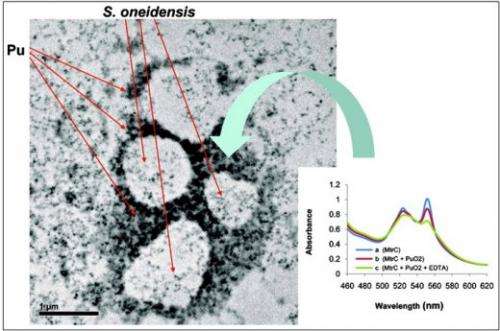New study queries interactions of metal-reducing bacteria with plutonium oxide

(PhysOrg.com) -- Recent work by scientists at Pacific Northwest National Laboratory has shed new light on the perplexing environmental chemistry of plutonium. They demonstrated that under anaerobic, or oxygen-free, conditions, plutonium(IV) hydrous oxide, the most common subsurface form of plutonium, does not become very soluble. In fact, this amorphous Pu solid becomes more crystalline when it contacts dissimilatory iron-reducing bacteria (DIRB).
However, other compounds disposed with the Pu also interact with it. When Pu comes in contact with EDTA, a chelating agent, its oxidation state decreases, and the resulting chemical form is dramatically more soluble. In addition, Pu's reduction and increase in solubility is dramatically increased by the electron shuttle anthraquinone-2,6-disulfonate, or AQDS.
Underneath some locations at the Hanford Site in southeastern Washington State, plutonium and other radioactive contaminants exist as a result of past plutonium production efforts at the site. Scientists at PNNL and collaborators have been studying the biogeochemistry of the subsurface to understand the environmental factors impacting the fate and transport of Pu in the subsurface.
This information is needed to develop effective approaches for isolating and removing the contaminants before they can impact humans and the environment. Plutonium in particular is a challenge to study, because of the complexity of its chemistry and the difficulty of working with it because of the extensive safety precautions required.
The purpose of this study was to determine the extent to which the iron-reducing bacteria, Shewanella oneidensis and Geobacter sulfurreducens, reduce and solubilize Pu(IV) hydrous oxide in the presence and absence of potential abiotic complexants. A second purpose was to determine the effect of AQDS on the rate and extent of Pu(IV) reduction and solubilization.
The research, which appears in the American Chemical Society journal Environmental Science & Technology, adds to the understanding of potential processes affecting prediction of plutonium mobility. It provides additional evidence that Pu(III) combined with a chelating agent is more likely to be mobile, thus able to reach the water table and other environment, than Pu(IV) combined with the same agent. It also highlights the environmental importance of colloidal plutonium—meaning that instead of moving as a dissolved salt, the radionuclide may move as a very tiny suspended form.
The scientists systematically studied mobilization and speciation, or evolution, of plutonium in the presence of various combinations of DIRB, EDTA, and AQDS, along with hydrogen (H2), a strong reductant and energy source for bacteria that can be formed in the environment either biotically or abiotically. They used liquid scintillation counting, solvent extraction, and optical absorbance spectrometry to show that in the absence of EDTA, Pu(IV) hydroxide reduction results in many orders of magnitude less Pu mobilization than in the presence of EDTA.
Using X-ray absorption spectroscopy at Argonne National Laboratory and transmission electron microscopy at the University of Nevada, Las Vegas, they showed that Pu(IV) hydroxide becomes more crystalline in the presence of DIRB or MtrC, an electron transfer protein isolated and characterized by PNNL scientists from Shewanella oneidensis. Abiotic controls provided novel results on abiotic reduction and solubilization of plutonium hydrous oxide in the presence of H2.
"Beyond its direct environmental relevance to plutonium mobility, our study gave us an unusual opportunity to interrogate plutonium redox chemistry using biology, while also exploring biology using an unusual solid-phase geochemical, plutonium hydrous oxide," said Andy Plymale, a PNNL scientist and lead author of the paper.
The scientists want to address the fate of the reduced and soluble Pu(III)-EDTA under conditions that could re-oxidize the Pu. Also of interest is the extent to which the Pu(III) could form mobile colloids under environmental conditions. Likewise, of environmental interest are the effects of natural subsurface milieu on the solubility of the reduced Pu; for example, recent work at PNNL showed that phosphate, a common nutrient anion, can form strong insoluble precipitates with Pu(III), retarding its mobility.
More information: Plymale AE, et al., Jr. 2012. "Biotic and Abiotic Reduction and Solubilization of Pu(IV)O2•xH2O(am) as Affected by Anthraquinone-2,6-disulfonate (AQDS) and Ethylenediaminetetraacetate (EDTA)." Environmental Science & Technology 46(4):2132-2140, DOI: 10.1021/es2030752
Journal information: Environmental Science & Technology
Provided by Pacific Northwest National Laboratory


















